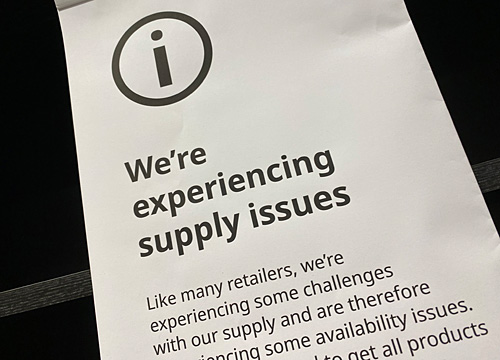The Evolving Supply-Chain Crisis
Want more free featured content?
Subscribe to Insights in Brief

Supply chains around the world have been experiencing continual disruption from a variety of factors, including trade barriers, geopolitical instability, civil unrest, talent shortages, energy shortages, demand shifts, extreme-weather events, and the ongoing effects of the covid‑19 pandemic. These factors will likely continue to disrupt supply chains for the foreseeable future, creating severe challenges for business and society. Among their other negative effects, supply-chain disruptions increase inflation, reduce manufacturing output, trigger business failures, exacerbate political instability, intensify geopolitical competition, and reduce overall economic growth. In addition, supply-chain disruptions are slowing down the world's transition to renewable energy, which increases the likelihood that the world will experience disastrous climate-change impacts.
As SoC1257 — Supply Shortages discusses, global supply chains began experiencing a crisis during the latter half of 2020, when the covid‑19 pandemic's effects simultaneously triggered exceptionally severe shifts in demand for goods and caused severe slowdowns and closures across industries that participate in the production and transportation of goods. Although the pandemic's effects have subsequently eased across most major economies, the supply-chain crisis has continued to develop because of multiple factors that are interacting with one another in complex ways. Sections below describe some important drivers of the global supply-chain crisis and discuss how these drivers might plausibly develop.
- Deglobalization and trade barriers. SoC1305 — The Shifting Extent of Globalization highlights that factors such as rising tariffs and other trade barriers, declining global flows of long-term investment, increasingly restrictive migration policies, and falling immigration rates have been contributing to an overall erosion of globalization. Reduced globalization can contribute to supply-chain disruptions—particularly in the semiconductor-manufacturing and other industries that depend on complex, interconnected multinational supply chains that have few suppliers for critical components. At the same time, supply-chain disruptions have contributed to deglobalization as governments, companies, and other stakeholders have sought to mitigate supply-chain risks by increasing investment in localized manufacturing and resource extraction. Eventually, the world could see the emergence of a feedback loop in which deglobalization contributes to supply-chain disruptions, supply-chain disruptions motivate stakeholders to take actions that contribute to deglobalization, and these actions further exacerbate supply-chain disruptions. Alternatively, feedback effects between deglobalization and supply-chain disruptions could motivate politicians to take drastic measures to alleviate trade barriers and promote global trade.
- Geopolitical conflict and instability. Geopolitical conflict and instability have exacerbated deglobalization and have otherwise contributed to the supply-chain crisis directly. As SoC1296 — Potential Impacts of Russia's Invasion of Ukraine discusses, Russia's invasion of Ukraine accelerated deglobalization by driving countries and companies to sever economic ties with Russia. At the same time, the conflict in Ukraine has disrupted supplies of food, raw materials, and energy among Russia, Ukraine, and their various trading partners. Future geopolitical conflicts in areas such as the South China Sea and the Middle East could cause disruptions equal to or greater than the disruption that the conflict between Russia and Ukraine has created and could likewise contribute to deglobalization. Meanwhile, deglobalization could increase the risk of geopolitical conflict by reducing rivals' economic interdependence, which could otherwise have acted as a conflict deterrent.
- Competition for food, water, and resources. Disruption in the flows of key raw materials and disruptions in food production have contributed to the supply-chain crisis and have driven geopolitical conflict. Competition for key resources will likely increase as countries and companies scramble to secure raw-material supplies that are necessary for the world's green-energy transition. Likewise, factors such as climate change, water-system disruptions, and biodiversity loss will continue to cause food-supply disruptions.
- Talent scarcity. SoC1281 — Talent Scarcity explains that the covid‑19 pandemic exacerbated shortages of labor in key industries (including the education, health-care, agriculture, and logistics industries), which in turn contributed to the supply-chain crisis. Although the pandemic's immediate direct effects on labor have diminished, covid‑19 has nevertheless reduced labor-force strength by causing excess death and disability. Other factors affecting talent scarcity include population aging, limits on migration, the high cost and complexity of training workforces, and shifts in worker attitudes and preferences. Such factors will likely continue to fuel talent scarcity—even if reduced economic growth leads to temporary increases in unemployment that reduce worker power.
- Energy costs. The global energy crisis that began in 2021 disrupted supplies of critical goods such as fertilizer, causing reverberations across other components of global supply chains. The conflict between Russia and Ukraine substantially intensified the energy crisis and triggered an acceleration in shifts to renewable energy. As SoC1289 — Renewable-Energy-Cost Trends discusses, suppliers of components and raw materials for renewable-energy systems have had difficulty in keeping up with growing demand, leading to a supply-chain crisis in miniature for renewable-energy systems and slowing down the rate at which renewable-energy systems have been decreasing in cost. Energy supplies will likely see continued disruption from factors such as deglobalization, geopolitical conflict, and renewable-energy-supply-chain constraints, which will exacerbate the supply-chain crisis.
- Extreme-weather effects. As the climate crisis intensifies, extreme-weather events that disrupt global supply chains are becoming increasingly common and disruptive. Many such events occurred during 2022 and inflicted severe harm on supply chains. For example, droughts in China, Europe, and the United States reduced water levels in major navigable rivers to the point at which shipping capacity on those rivers became substantially impaired. Likewise, droughts and heat waves damaged crops in key growing regions, exacerbating shortages in food supplies. Because the climate crisis is certain to worsen, supply chains will face increasingly severe weather-related disruptions, prolonging and intensifying the global supply-chain crisis.